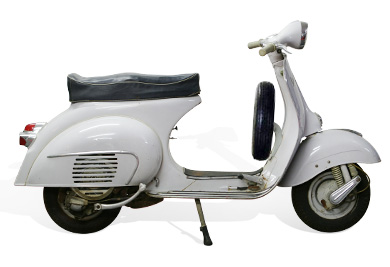Sangat baik
4.7 / 5
Pengiriman hari ini dengan pesanan di 2 h 20 min
Gratis ongkos kirim mulai dari 99 € (DE)
Kepuasan pelanggan yang tinggi
Pengiriman hari ini dengan pesanan di 2 h 20 min

Logo Vespa dan joknya kini berwarna biru tua. Lampu belakang tidak lagi dicat, melainkan dilapisi krom. Sebagai pengganti lis pijakan kaki di bagian tengah, kini dipasang karpet karet dengan lis dekoratif di samping. Spatbor depan sedikit berubah bentuk dibandingkan model sebelumnya dan kini memiliki garis lekukan di sisi. Tameng kaki dilengkapi dengan lis aluminium berlubang.
Pada VNB4T yang juga diperkenalkan tahun 1962, perubahan hanya sedikit. Mesin andalan tetap dipertahankan dan rangka hanya diubah di area dudukan plat nomor, yang kini berbentuk kotak. Skuter ini dikirim dalam warna abu-abu terang (MaxMeyer 1.298.8707). Jarak sumbu roda dipersingkat 2 cm. Kampas rem belakang kini dipasang dengan dua baut, bukan lagi tumpang tindih pada satu baut. Panel samping diberi aksen lis krom.
Pada tahun 1963, VNB5T menjadi model pertama yang menggunakan mesin dengan transmisi 4-percepatan. Rasio total tetap sama, namun jarak antar gigi dibuat lebih rapat.
Dengan VNB6T mulai tahun 1964, hanya ada perubahan kecil. Mur pengunci roda diperkuat (dari 8 mm menjadi 10 mm). Selain itu, mur roda tidak lagi memiliki titik las. Lampu belakang menggunakan model dari Vespa Super. Secara teknis, rasio kompresi mesin 4-percepatan ditingkatkan dari 7,2:1 menjadi 7,7:1. Ini meningkatkan tenaga dari 4,6 menjadi 5,12 hp.
Nomor rangka VNB5 berdasarkan tahun:
1963: VNB5T 1001–7070
1964: VNB5T 7071–43240



